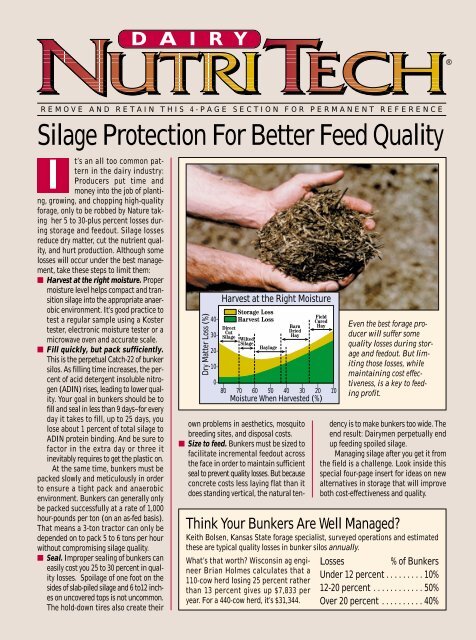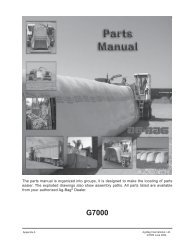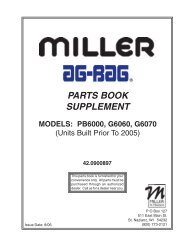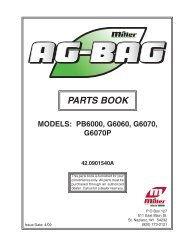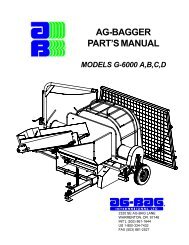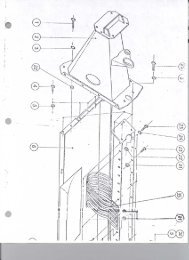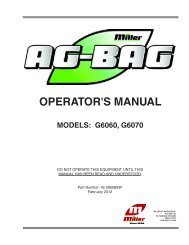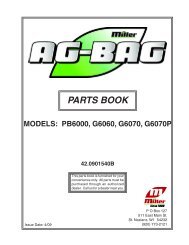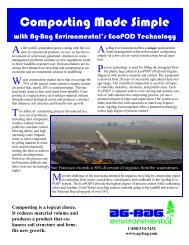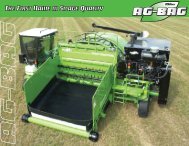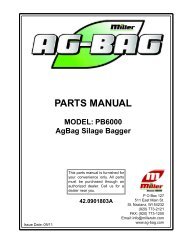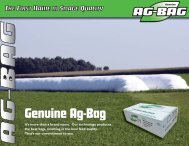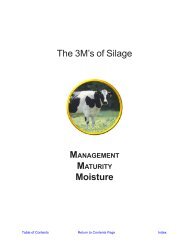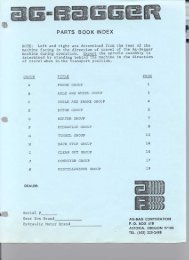You also want an ePaper? Increase the reach of your titles
YUMPU automatically turns print PDFs into web optimized ePapers that Google loves.
D A I R Y<br />
REMOVE AND RETAIN THIS 4-PAGE SECTION FOR PERMANENT REFERENCE<br />
Silage Protection For Better Feed Quality<br />
I<br />
t’s an all too common pattern<br />
in the dairy industry:<br />
Producers put time and<br />
money into the job of planting,<br />
growing, and chopping high-quality<br />
forage, only to be robbed by Nature taking<br />
her 5 to 30-plus percent losses during<br />
storage and feedout. Silage losses<br />
reduce dry matter, cut the nutrient quality,<br />
and hurt production. Although some<br />
losses will occur under the best management,<br />
take these steps to limit them:<br />
■ Harvest at the right moisture. Proper<br />
moisture level helps compact and transition<br />
silage into the appropriate anaerobic<br />
environment. It’s good practice to<br />
test a regular sample using a Koster<br />
tester, electronic moisture tester or a<br />
microwave oven and accurate scale.<br />
■ Fill quickly, but pack sufficiently.<br />
This is the perpetual Catch-22 of bunker<br />
silos. As filling time increases, the percent<br />
of acid detergent insoluble nitrogen<br />
(ADIN) rises, leading to lower quality.<br />
Your goal in bunkers should be to<br />
fill and seal in less than 9 days–for every<br />
day it takes to fill, up to 25 days, you<br />
lose about 1 percent of total silage to<br />
ADIN protein binding. And be sure to<br />
factor in the extra day or three it<br />
inevitably requires to get the plastic on.<br />
At the same time, bunkers must be<br />
packed slowly and meticulously in order<br />
to ensure a tight pack and anaerobic<br />
environment. Bunkers can generally only<br />
be packed successfully at a rate of 1,000<br />
hour-pounds per ton (on an as-fed basis).<br />
That means a 3-ton tractor can only be<br />
depended on to pack 5 to 6 tons per hour<br />
without compromising silage quality.<br />
■ Seal. Improper sealing of bunkers can<br />
easily cost you 25 to 30 percent in quality<br />
losses. Spoilage of one foot on the<br />
sides of slab-piled silage and 6 to12 inches<br />
on uncovered tops is not uncommon.<br />
The hold-down tires also create their<br />
Dry Matter Loss (%)<br />
40-<br />
30-<br />
20-<br />
10-<br />
0-<br />
Harvest at the Right Moisture<br />
|<br />
80<br />
| | | | | |<br />
70 60 50 40 30 20<br />
Moisture When Harvested (%)<br />
own problems in aesthetics, mosquito<br />
breeding sites, and disposal costs.<br />
■ Size to feed. Bunkers must be sized to<br />
facilitate incremental feedout across<br />
the face in order to maintain sufficient<br />
seal to prevent quality losses. But because<br />
concrete costs less laying flat than it<br />
does standing vertical, the natural ten-<br />
Even the best forage producer<br />
will suffer some<br />
quality losses during storage<br />
and feedout. But limiting<br />
those losses, while<br />
maintaining cost effectiveness,<br />
is a key to feeding<br />
profit.<br />
dency is to make bunkers too wide. The<br />
end result: Dairymen perpetually end<br />
up feeding spoiled silage.<br />
Managing silage after you get it from<br />
the field is a challenge. Look inside this<br />
special four-page insert for ideas on new<br />
alternatives in storage that will improve<br />
both cost-effectiveness and quality.<br />
Think Your Bunkers Are Well Managed?<br />
Keith Bolsen, Kansas State forage specialist, surveyed operations and estimated<br />
these are typical quality losses in bunker silos annually.<br />
What’s that worth? Wisconsin ag engineer<br />
Brian Holmes calculates that a<br />
110-cow herd losing 25 percent rather<br />
than 13 percent gives up $7,833 per<br />
year. For a 440-cow herd, it’s $31,344.<br />
|<br />
10<br />
Losses % of Bunkers<br />
Under 12 percent . . . . . . . . . 10%<br />
12-20 percent . . . . . . . . . . . . 50%<br />
Over 20 percent . . . . . . . . . . 40%<br />
®
Total annual<br />
storage costs<br />
for a bagging<br />
system can run<br />
14 to 18 percent<br />
less than<br />
bunkers,<br />
research shows.<br />
A high-quality plastic<br />
bag seals out sunlight<br />
and oxygen, maintaining<br />
fermentation<br />
and limiting dry matter<br />
losses.<br />
NUTRITECH ®<br />
<strong>Bag</strong>ged Systems Offer a Viable Alternative to Concrete<br />
A<br />
lthough the ever-present tower silo<br />
used to be the predominant means of<br />
ensiling on established dairies, many<br />
producers have reached a point that<br />
demands change. Old upright silos require overhaul.<br />
Climbing to change doors and service<br />
unloaders becomes more difficult. Excessive drymatter<br />
losses spur a drive for lower cost/higher<br />
quality silage. Many expanding dairies simply<br />
can’t build sufficient vertical storage, so bunkers<br />
are favored.<br />
But the drive for efficiency in feed storage<br />
has led many dairy producers to turn to a relatively<br />
new option. Storing chopped silage and wet<br />
hay in large plastic bags is a relatively recent<br />
practice compared to the more traditional methods.<br />
Using a machine that stores and compacts<br />
silage in specially made plastic bags, the system<br />
ferments feed in long, horizontal, oxygen-deficient<br />
tubes until needed for feeding. Why are producers<br />
finding bags to be a better option?<br />
Flexibility. Because virtually all of the system’s<br />
investment is in mobile machinery and bags, not<br />
concrete or blue steel, a bag-based system is highly<br />
flexible. The equipment is easily moved if needed,<br />
bags can be gradually phased into an operation—<br />
especially with the help of a custom bagger. And<br />
Typical Capital Investment To ensile 4,389 wet tons<br />
BUNKER<br />
• 8 above ground bunkers with shared walls<br />
• 20' x 320' apron; 42,400 sq. ft.excavation/fill<br />
@ 32¢ + 30,400 sq. ft. apron@ $1.80<br />
• Subtotal $121,428 + packing<br />
tractor $7,875 +loader $6,300 = Total $135,603<br />
because bags can be sealed easily, harvesting can<br />
be spread over a relatively long period if necessary,<br />
and feeding out leaves no exposed silage face to spoil.<br />
Each cutting or field of forage harvested under<br />
different conditions can be stored in its own bag,<br />
indexed by quality in order to easily change ingredients<br />
to maximize forage quality in the ration.<br />
Cost-effectiveness. When compared with new<br />
construction, a bag-based system shows a lower<br />
initial investment than concrete-based ones. And<br />
when compared to existing structures, if you look<br />
at all annual costs, including ownership costs and<br />
cost of spoilage, bags are the most cost-effective<br />
option, according to recent Wisconsin research.<br />
Lower storage losses. Because ensiling and<br />
sealing are more dependable than other horizontal<br />
storage, bagging produces a higher quality<br />
silage. Storage losses are comparable with tower<br />
silos and much lower than bunker silos.<br />
Safer. <strong>Bag</strong>ging silage reduces the conventional<br />
safety hazards of silage management. Their low<br />
height virtually eliminates the No. 1 cause of silorelated<br />
deaths: falling from elevation. And<br />
although bags aren’t immune from silage gas,<br />
according to New York research, even dangerous<br />
levels of gas are more likely to be vented quickly<br />
in the open air where bags are stored.<br />
BAGS<br />
• 32 - 8' x 150' bags stored 3' apart<br />
• 155' x 352' stone storage pad @ 50¢<br />
+ PTO powered bagger $17,400<br />
• Subtotal $44,680 + bagging<br />
tractor $3,375 + loader $6,300 = Total $54,355<br />
Assumes packing and bagging tractors devote 10 percent of total lifetime use to silage work; loader, 20 percent.<br />
Source: B Holmes, University of Wisconsin, 1996.<br />
Compare All Costs<br />
When you look at all ownership costs – interest and principal<br />
on capital; operational costs such as labor, maintenance,<br />
repairs, fuel, plastic, and property tax; plus the value of<br />
spoilage – bags beat other storage in cost effectiveness,<br />
University of Wisconsin research shows.<br />
Herd Size1 55 cows 110 cows 219 cows<br />
Wet Quantity 2 1,097 tons 2,194 tons 4,389 tons<br />
Dry Quantity 384 ton DM 768 ton DM 1,536 ton DM<br />
Initial Capital Investment<br />
Concrete Stave $73,825 $105,985 $202,345<br />
Concrete Bunker $58,525 $78,945 $135,603<br />
<strong>Bag</strong>ged Silage $33,895 $40,715 $54,355<br />
Annual Storage Costs ($/Year)<br />
Concrete Stave $17,502 $27,755 $53,702<br />
Concrete Bunker $17,290 $28,219 $53,027<br />
<strong>Bag</strong>ged Silage $14,703 $24,322 $43,562<br />
1. Estimates based on 7.0 ton DM forage/adult cow with replacement/year.<br />
2. Estimates assume 65% moisture content. (Source: Holmes, 1995, modified)
Compare the Results<br />
Effects of silage system on<br />
feed production for 100-cow,<br />
270-acre dairy farm<br />
370-<br />
360-<br />
350-<br />
340-<br />
330-<br />
320-<br />
310-<br />
300-<br />
290-<br />
280-<br />
270-<br />
Actual alfalfa silage production…tons DM<br />
Source: Rotz & Gupa, 1996.<br />
Concrete Stave Silo<br />
Effects of silage system on<br />
animal production for 100-cow,<br />
270-acre dairy farm<br />
Effects of silage system on<br />
net return for 100-cow,<br />
270-acre dairy farm<br />
Total dry matter loss<br />
occurring on 25-year<br />
average results<br />
21,500-<br />
80,000-<br />
25%-<br />
21,000-<br />
70,000-<br />
60,000-<br />
20%-<br />
20,500-<br />
50,000-<br />
40,000-<br />
15%-<br />
20,000-<br />
30,000-<br />
10%-<br />
19,500-<br />
20,000-<br />
10,000-<br />
5%-<br />
19,000-<br />
Source: C. Alan Rotz, Ph.D., US<br />
0-<br />
NOTE: Net return to management is<br />
0-<br />
Source: C. Alan Rotz, Ph.D.,<br />
Dairy Forage Research Center/ total production costs minus milk, US Dairy Forage Research<br />
Michigan State University animal and feed income.<br />
Source: Rotz & Gupa, 1996.<br />
Center/ Michigan State University<br />
Uncovered Bunker Silo Silage <strong>Bag</strong>s (chopped) Wrapped Silage Bales<br />
Average milk production...lb./cow<br />
Haylage, Too<br />
Because hay-crop silage yields relatively low<br />
tons per cutting, the flexible nature of a bagbased<br />
system makes it a natural solution to<br />
ensile hay. Whatever amount is harvested<br />
can be sealed at harvest, rather than layered<br />
as is traditionally attempted in conventional<br />
silos storing a whole season’s haylage. The<br />
high number of spoilage layers are eliminated,<br />
leading to higher quality haylage.<br />
Tips to Better Manage a <strong>Bag</strong>-based System<br />
Net return to management...$/year<br />
■ Use a quality bag. Storage life is a function of bag quality: Low-quality bags allow more oxygen<br />
to infiltrate, interfering with fermentation. High-quality bags resist damage caused by sunlight<br />
and oxygen infiltration over long periods of time.<br />
■ Apply a fermentation inoculant. This is particularly important to hay crops, in which sugar<br />
and starch levels are lower than corn. Research shows that even the best managed silage can<br />
benefit from an effective inoculant that rapidly reduces pH and prevents heat.<br />
■ Manage the site. At least a third of total bags should be sited on well-drained ground you can<br />
easily access and unload without problems during wet weather. All bags should be placed on<br />
flat, non-saturated ground, on a low-cost pad of gravel, packed sand or crushed lime.<br />
■ Store bags on a clean site free of vegetation and trash, away from livestock areas.<br />
■ Observation is important in the bag storage area. The placement of bag pad will determine<br />
how often you need to check on bags. Repairs are easily made with repair tape. It is critical the<br />
feed remain oxygen free.<br />
■ When unloading the silage from the bags, use a front end loader or skid steer. The small feedout<br />
face on the bag is easier to manage.<br />
■ Sampling forage from the bag is very easy. Samples can be tested from various spots in the<br />
bags prior to feeding. This allows easy changes in the TMR as necessary. You know at any time<br />
exactly the quality you are feeding.<br />
■ Another advantage of using the bag system is that it can be introduced to your present system<br />
by a custom operator or rental, prior to purchase. Expansions to larger herds are very easy with<br />
this system, as it offers a great deal of flexibility.<br />
Percentage of dry matter loss<br />
Because<br />
ensiling and<br />
sealing is more<br />
dependable<br />
than other<br />
horizontal<br />
storage,<br />
bagging has<br />
been shown to<br />
produce a<br />
higher quality<br />
silage.<br />
Consider Safety<br />
Major causes of<br />
accidents in tower silos<br />
were falls, unloader<br />
entanglement and silo<br />
gas. Side collapse was<br />
the primary cause of<br />
accidents in trenches.<br />
Fatal Accidents<br />
Tower Silos . . . . . 25<br />
Bunker/Trench . . 5<br />
<strong>Bag</strong>ged Silage. . . . 0<br />
Source: “Fatal Accidents in Work<br />
with Silage in Wisconsin 1987-<br />
1996.” Based on accidents reported<br />
in the local Wisconsin press,<br />
ASPS, 1996.<br />
NUTRITECH ®
<strong>Ag</strong>-<strong>Bag</strong> ® Systems Offer The Storage Solution<br />
S<br />
ince 1978, <strong>Ag</strong>-<strong>Bag</strong> International,<br />
Ltd. has pioneered bagging as<br />
an efficient—and cost-effective—alternative<br />
to bunkers,<br />
piles, pits, silos, bales and stacks. <strong>Ag</strong>-<strong>Bag</strong>’s<br />
system stores silage, haylage and high-moisture<br />
grain in oxygen-limited, durable plastic<br />
bags of up to 500 feet in length and up<br />
to 12 feet in diameter. Anaerobic packing<br />
is ensured by using machines manufactured<br />
specifically for the purpose of filling the<br />
bags. Full width feed deflectors, laser cut<br />
stripper bars, and full 1-inch teeth ensure<br />
even compaction. As the bag is filled, the<br />
bagger moves forward. Self-aligning steel<br />
cables with MICO disk braking guarantee<br />
G6000 <strong>Ag</strong>-<strong>Bag</strong>ger ®<br />
• 8', 9' or 10' diameter bags<br />
• PTO-driven<br />
• 65 to 85 HP required<br />
• Easily handles 3,000 to 5,000 tons<br />
per year.<br />
G6700 <strong>Ag</strong>-<strong>Bag</strong>ger ®<br />
• 8' or 9' diameter bags<br />
• PTO-driven • 100 HP required<br />
• 3,000 to 6,000 tons per year.<br />
M7000 <strong>Ag</strong>-<strong>Bag</strong>ger ®<br />
• 9' or 10' diameter bags<br />
• Self-propelled by 120-HP<br />
John Deere diesel.<br />
• Also available PTO-driven, 90 to 150<br />
HP required (Model G7000).<br />
• 6,000 to 20,000 tons per year.<br />
the best feed compaction on the market.<br />
With <strong>Ag</strong>-<strong>Bag</strong> storage, you get less<br />
waste and better feed at lower cost. That<br />
means more production and more profits.<br />
You can store at variable moisture<br />
levels, which means a much wider range<br />
of acceptable weather conditions for<br />
harvest. It also means earlier harvest<br />
and reduced weather risks...in some<br />
areas even an extra cutting.<br />
The exterior white layer of <strong>Ag</strong>-<strong>Bag</strong>’s<br />
unique 3-ply construction repels solar<br />
heat and keeps contents cooler. The<br />
black inner lining keeps out sunlight and<br />
preserves valuable nutrients. With UV<br />
inhibitors to resist sun damage, each <strong>Ag</strong>-<br />
<strong>Bag</strong> Tri-Dura ® bag is built to last two<br />
years under rugged weather conditions.<br />
<strong>Ag</strong>-<strong>Bag</strong> puts unlimited, low-cost storage<br />
capacity where you need it. Feed can<br />
be removed from the bags, which eliminates<br />
spoilage created by poor face management<br />
in other storage systems.<br />
<strong>Ag</strong>-<strong>Bag</strong> International manufactures<br />
a complete system offering the finest quality<br />
equipment and silage bags to produce<br />
the most cost-effective and highest quality<br />
silage and grain. We also produce a complete<br />
line of equipment for the round and<br />
square bale silage markets. <strong>Ag</strong>-<strong>Bag</strong> systems<br />
are sold through dealers and distributors<br />
worldwide.<br />
Let Us Help You Put Up The Best Quality Feed For A Lower Cost.<br />
M10,000 <strong>Ag</strong>-<strong>Bag</strong>ger ®<br />
• 12' diameter bags<br />
• Self-propelled via 425-HP John Deere<br />
PowerTech.<br />
• Handles 8,000 to 100,000 tons annually.<br />
<strong>Ag</strong>-<strong>Bag</strong> now has the option of using cable<br />
machines or the new HFC series of cableless<br />
machines. Call for more information.<br />
<strong>Ag</strong>-<strong>Bag</strong> Tri-Dura ® <strong>Bag</strong>s<br />
• Specifically developed for this technology<br />
• All needed diameters, 100' to 500' long.<br />
• Recyclable.<br />
2320 SE <strong>Ag</strong>-<strong>Bag</strong> Lane • Warrenton, OR 97146<br />
(800) 334-7432 • www.ag-bag.com • silage@ag-bag.com<br />
Bale storage systems<br />
• <strong>Ag</strong>-<strong>Bag</strong> Flex-A-Tuber ® for high-moisture<br />
round bales, oxygen limiting.<br />
• <strong>Ag</strong>-<strong>Bag</strong> Square Bale <strong>Bag</strong>ger ® for a<br />
variety of square bale sizes. Shrinks<br />
to limit oxygen.<br />
<strong>Ag</strong>-<strong>Bag</strong> Plus ®<br />
Inoculant<br />
• The only one<br />
made for<br />
bagging.<br />
• Soluble<br />
or dry<br />
• 5 lactic-acid<br />
producing<br />
strains and 2 enzymes.


